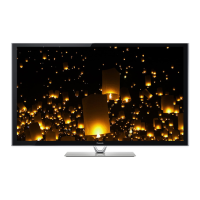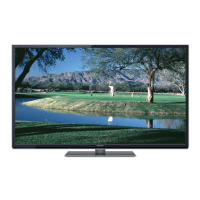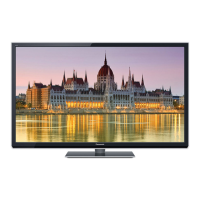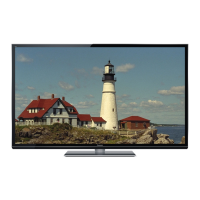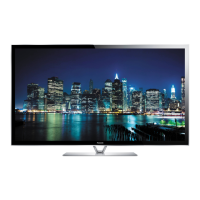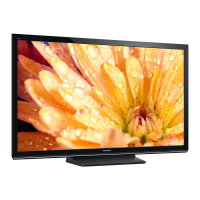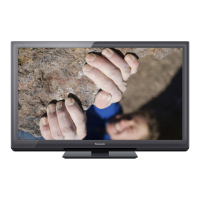Do you have a question about the Panasonic TC-P65VT30 and is the answer not in the manual?
Guidelines for repairs and servicing, including modification, wiring, and connector handling.
Procedure to measure leakage current with AC cord unplugged and jumper between plug prongs.
Procedure to measure leakage current with AC cord plugged in using resistor and capacitor.
Techniques to reduce damage to sensitive components from static electricity during handling.
Information on lead-free solder composition, melting points, and handling precautions for repairs.
Diagram showing PCB layout and names within the unit, with a table of board names and functions.
Lists applicable input signals (Component, HDMI, PC) and their frequencies for the TV.
Technical specifications for the TV: power, display, sound, connections, dimensions, and operating conditions.
Specifications for 3D eyewear: lens type, usage, charging, battery, materials, and dimensions.
Specifications for wireless LAN adaptor: power, antenna, interface, compliance, access modes, dimensions, and mass.
Details on KEY specifications for DTCP-IP, WMDRM, and Widevine, including general information and IC replacement.
Specifications for RS232C service port: communication parameters, connection diagrams, and control data format.
Procedure to access Service Mode: purpose, key commands, and exit method.
Details on adjustment mode: hexadecimal values, preset differences, and items for adjustment.
Function to reverse picture display (left/right, up/down) with possible cause indication.
Procedure for accessing service tool mode: SOS history and power time/count display.
Functionality and access for Hotel mode to restrict functions for hotel environments.
Procedure for copying data (board replacement, hotel setup) using an SD card.
Procedure to check IIC bus lines using self-check indications for troubleshooting.
Steps on how to access the self-check indications for IIC bus lines.
Instructions on how to exit the IIC bus line check.
Description of the screen display format for IIC bus line checks.
Confirms parts to check if NG was displayed during IIC bus line check.
Chart detailing power LED blinking patterns and corresponding check points for troubleshooting.
Troubleshooting guide for 'No Power' condition, outlining two states indicated by the power LED.
Troubleshooting flowchart for 'No Picture' issues, guiding checks on OSD, SC board, and SS board.
Identifies possible defective PCBs for local area failures on the plasma display screen.
Purpose, description, and usage instructions for the SC jig to find failure boards (SC or SU/SD).
Instructions for removing the rear cover of the unit.
Procedure for safely removing the AC inlet, including capacitor discharge and screw removal.
Steps for removing the P(MAIN) board, including capacitor discharge and connector disconnection.
Steps for removing the P(SUS) board, including capacitor discharge and connector disconnection.
Steps for removing the P(SUB) board, including capacitor discharge and connector disconnection.
Instructions for removing various terminal covers and shield metals from the unit.
Steps for removing the A-Board, including terminal covers, cable disconnection, and screw removal.
Instructions for disconnecting the connector and removing the side unit assembly.
Steps for removing the SU-Board, including flexible cable disconnection and screw removal.
Steps for removing the SD-Board, including flexible cable disconnection and screw removal.
Steps for removing the SC-Board, including connector and cable disconnection, and caution for thermal sheets.
Steps for removing the SS-Board, including connector, flexible cable, and screw removal.
Steps for removing the SS2-Board, including flexible cable and screw removal.
Instructions for removing the fan, including cable clampers, screws, and relay connector.
Steps for removing speakers, including cable clampers, screws, shield metal, and relay connector.
Steps for removing the woofer, including cable clampers, relay connector, and screw removal.
Procedure for removing the stand bracket, involving panel handling and screw removal.
Steps for removing the K-Board, including shield metal, stand bracket, screw, and connector removal.
Steps for removing the S-Board, including shield metal, screw, and connector removal.
Steps for removing the V-Board, including shield metal, stand bracket, screw, and connector removal.
Steps for removing handles, including shield metal and screw removal.
Steps for removing the bottom cabinet assembly, including speakers, stand bracket, and boards.
Procedure for separating the plasma panel section from the cabinet assembly.
Steps for removing contact metals from the cabinet assembly, including tape, screws, and different metal parts.
Steps for removing the C1-Board, including contact metal bottom, cable, and connector disconnection.
Steps for removing the C2-Board, including contact metal bottom, flexible cables, and screws.
Steps for removing the C3-Board, including contact metal bottom, flexible cables, and connector.
Steps for removing AL frames and corner fixing metals.
Cautionary procedure for replacing the plasma panel, emphasizing careful handling of the fragile panel.
General instructions for measurements and adjustments, focusing on Vsus selection.
Procedure to select Vsus to LOW or HIGH after panel or A-board replacement.
Procedure for adjusting RF video sub contrast using a color bar pattern and service mode.
Detailed steps for white balance adjustment using a color analyzer, covering picture menu and color temperature settings.
Overall block diagram illustrating the main components and signal flow of the TV.
Detailed block diagram (part 1 of 4) showing specific functional blocks and interconnections.
Detailed block diagram (part 2 of 4) illustrating more functional blocks and their connections.
Detailed block diagram (part 3 of 4) showing power supply and control circuits.
Detailed block diagram (part 4 of 4) illustrating scan drive and sustain drive circuits.
Cautionary statement regarding correct assembly and locking of flexible cables in connectors.
Diagram showing wiring connections for part 1 of the overall wiring diagram.
Diagram illustrating wiring connections for part 2 of the overall wiring diagram.
Diagram showing wiring connections for part 3, including relay connectors and cable routing.
Diagram illustrating wiring connections for part 4, including fan and other board connections.
Diagram showing wiring connections for part 5, detailing cable routing and connector placements.
Diagram illustrating wiring connections for part 6, focusing on internal cable connections of the P-Board.
Guidelines for repairs and servicing, including modification, wiring, and connector handling.
Procedure to measure leakage current with AC cord unplugged and jumper between plug prongs.
Procedure to measure leakage current with AC cord plugged in using resistor and capacitor.
Techniques to reduce damage to sensitive components from static electricity during handling.
Information on lead-free solder composition, melting points, and handling precautions for repairs.
Diagram showing PCB layout and names within the unit, with a table of board names and functions.
Lists applicable input signals (Component, HDMI, PC) and their frequencies for the TV.
Technical specifications for the TV: power, display, sound, connections, dimensions, and operating conditions.
Specifications for 3D eyewear: lens type, usage, charging, battery, materials, and dimensions.
Specifications for wireless LAN adaptor: power, antenna, interface, compliance, access modes, dimensions, and mass.
Details on KEY specifications for DTCP-IP, WMDRM, and Widevine, including general information and IC replacement.
Specifications for RS232C service port: communication parameters, connection diagrams, and control data format.
Procedure to access Service Mode: purpose, key commands, and exit method.
Details on adjustment mode: hexadecimal values, preset differences, and items for adjustment.
Function to reverse picture display (left/right, up/down) with possible cause indication.
Procedure for accessing service tool mode: SOS history and power time/count display.
Functionality and access for Hotel mode to restrict functions for hotel environments.
Procedure for copying data (board replacement, hotel setup) using an SD card.
Procedure to check IIC bus lines using self-check indications for troubleshooting.
Steps on how to access the self-check indications for IIC bus lines.
Instructions on how to exit the IIC bus line check.
Description of the screen display format for IIC bus line checks.
Confirms parts to check if NG was displayed during IIC bus line check.
Chart detailing power LED blinking patterns and corresponding check points for troubleshooting.
Troubleshooting guide for 'No Power' condition, outlining two states indicated by the power LED.
Troubleshooting flowchart for 'No Picture' issues, guiding checks on OSD, SC board, and SS board.
Identifies possible defective PCBs for local area failures on the plasma display screen.
Purpose, description, and usage instructions for the SC jig to find failure boards (SC or SU/SD).
Instructions for removing the rear cover of the unit.
Procedure for safely removing the AC inlet, including capacitor discharge and screw removal.
Steps for removing the P(MAIN) board, including capacitor discharge and connector disconnection.
Steps for removing the P(SUS) board, including capacitor discharge and connector disconnection.
Steps for removing the P(SUB) board, including capacitor discharge and connector disconnection.
Instructions for removing various terminal covers and shield metals from the unit.
Steps for removing the A-Board, including terminal covers, cable disconnection, and screw removal.
Instructions for disconnecting the connector and removing the side unit assembly.
Steps for removing the SU-Board, including flexible cable disconnection and screw removal.
Steps for removing the SD-Board, including flexible cable disconnection and screw removal.
Steps for removing the SC-Board, including connector and cable disconnection, and caution for thermal sheets.
Steps for removing the SS-Board, including connector, flexible cable, and screw removal.
Steps for removing the SS2-Board, including flexible cable and screw removal.
Instructions for removing the fan, including cable clampers, screws, and relay connector.
Steps for removing speakers, including cable clampers, screws, shield metal, and relay connector.
Steps for removing the woofer, including cable clampers, relay connector, and screw removal.
Procedure for removing the stand bracket, involving panel handling and screw removal.
Steps for removing the K-Board, including shield metal, stand bracket, screw, and connector removal.
Steps for removing the S-Board, including shield metal, screw, and connector removal.
Steps for removing the V-Board, including shield metal, stand bracket, screw, and connector removal.
Steps for removing handles, including shield metal and screw removal.
Steps for removing the bottom cabinet assembly, including speakers, stand bracket, and boards.
Procedure for separating the plasma panel section from the cabinet assembly.
Steps for removing contact metals from the cabinet assembly, including tape, screws, and different metal parts.
Steps for removing the C1-Board, including contact metal bottom, cable, and connector disconnection.
Steps for removing the C2-Board, including contact metal bottom, flexible cables, and screws.
Steps for removing the C3-Board, including contact metal bottom, flexible cables, and connector.
Steps for removing AL frames and corner fixing metals.
Cautionary procedure for replacing the plasma panel, emphasizing careful handling of the fragile panel.
General instructions for measurements and adjustments, focusing on Vsus selection.
Procedure to select Vsus to LOW or HIGH after panel or A-board replacement.
Procedure for adjusting RF video sub contrast using a color bar pattern and service mode.
Detailed steps for white balance adjustment using a color analyzer, covering picture menu and color temperature settings.
Overall block diagram illustrating the main components and signal flow of the TV.
Detailed block diagram (part 1 of 4) showing specific functional blocks and interconnections.
Detailed block diagram (part 2 of 4) illustrating more functional blocks and their connections.
Detailed block diagram (part 3 of 4) showing power supply and control circuits.
Detailed block diagram (part 4 of 4) illustrating scan drive and sustain drive circuits.
Cautionary statement regarding correct assembly and locking of flexible cables in connectors.
Diagram showing wiring connections for part 1 of the overall wiring diagram.
Diagram illustrating wiring connections for part 2 of the overall wiring diagram.
Diagram showing wiring connections for part 3, including relay connectors and cable routing.
Diagram illustrating wiring connections for part 4, including fan and other board connections.
Diagram showing wiring connections for part 5, detailing cable routing and connector placements.
Diagram illustrating wiring connections for part 6, focusing on internal cable connections of the P-Board.
| 3D | Yes |
|---|---|
| Depth | 60.95 mm |
| Width | 1572.2 mm |
| Height | 957.58 mm |
| Safety | UL60065/C-UL |
| Weight | 56020 g |
| Tuner type | Analog & digital |
| Pixel pitch | - mm |
| Aspect ratio | 16:9 |
| Package depth | 378.46 mm |
| Package width | 1719.58 mm |
| Product color | Black |
| Package height | 1191.26 mm |
| Package weight | 76020 g |
| RMS rated power | 12 W |
| AC input voltage | 120 V |
| Display diagonal | 65 \ |
| AC input frequency | 60 Hz |
| Depth (with stand) | 401.32 mm |
| Display brightness | - cd/m² |
| Display technology | Plasma |
| Number of speakers | 2 |
| HDMI ports quantity | 4 |
| Height (with stand) | 995.68 mm |
| High frequency rate | 600 Hz |
| Weight (with stand) | 63010 g |
| Supported video modes | 1080i, 1080p, 480p, 720p |
| Card reader integrated | No |
| USB 2.0 ports quantity | 3 |
| S-Video inputs quantity | 0 |
| Contrast ratio (typical) | - |
| Screen format adjustments | 4:3, 16:9, Zoom |
| Analog signal format system | NTSC |
| Operating temperature (T-T) | 0 - 40 °C |
| Digital signal format system | ATSC |
| Supported graphics resolutions | 1920 x 1080 (HD 1080) |
| Component video (YPbPr/YCbCr) in | 1 |
